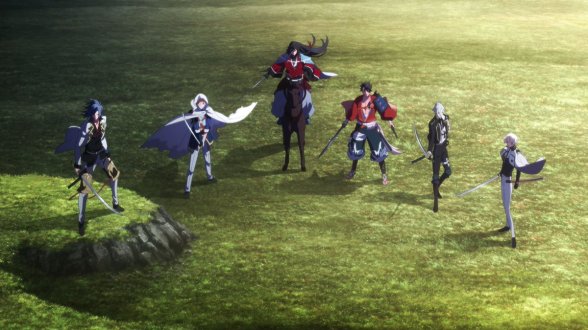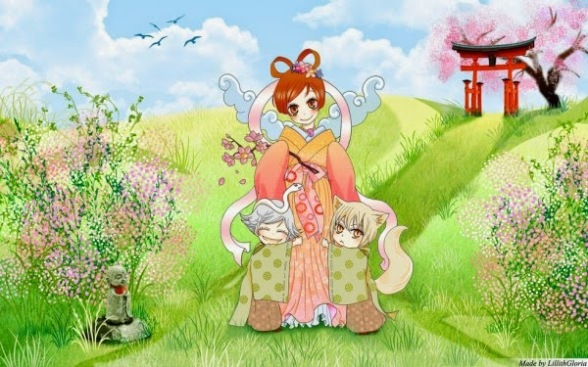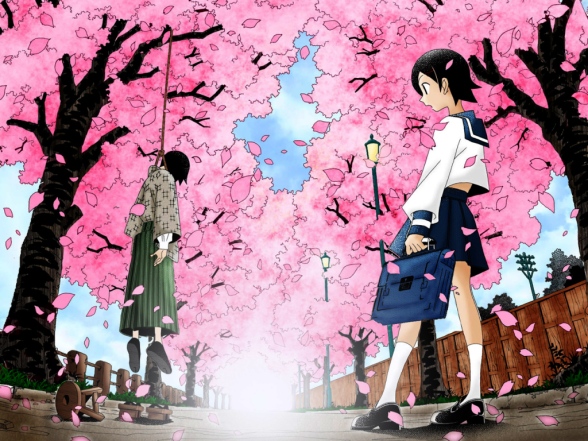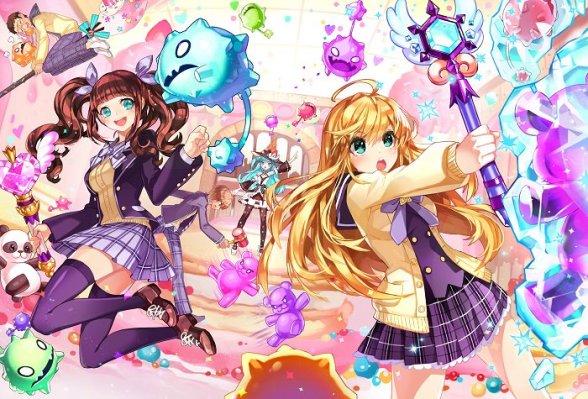Kayson Carlin
Bowling Green State University
October 10, 2018
The Crossover of Anime and Japanese Theatre
Perhaps the most recognizable Japanese theatre performance is Kabuki, known for it’s lavish costumes, make-up, and dramatic effects. In the late 1960’s, a new sub-genre called Super Kabuki was birthed, sometimes referred to as the “Hollywood” of Japanese theatre. Kabuki actor Ichikawa Ennosuke formed his own company with the idea of modernizing Kabuki. Ennosuke trimmed dialog, sped up the delivery of lines, and alternated fast-moving action scenes with slower ones that reveal emotion and characterization. He employed modern set, costume, and lighting designers, and revived theatrical trickery like quick costume changes, cascades of real water on stage, and flying on wires over the stage and out over the audience (Hornby p.517). This type of freedom in creativity and performance matches particularly well with anime, which commonly employs fantastical settings, complex physical actions, and deep characterization on screen. Using techniques and stunts from Super Kabuki, anime stage adaptions have found it’s niche within Japanese theatre.
Within a few years of the emergence of Super Kabuki, anime and manga were introduced to the stage. In the early 1970’s, the Takarazuka Revue, an all-female performance troupe, saw declining popularity in their productions. Fearing the end of the company, they sought after new, popular stories and adaptions to bring in greater audiences. In 1974, the Takarazuka group unveiled one of the first anime adapted performances ever; Riyoko Ikeda’s Rose of Versailles (1972). This led to an increased interest in not only theatre, but the respective source material as well. For the next 30 years, Japanese theatre would see more popular culture, such as anime and manga, make it’s way to the stage, including the supremely popular Sailor Moon in the mid-1990s. However it wasn’t until 2003, with the production of Prince of Tennis the Musical, that theatre saw such an influx of anime derived adaptions. “If you see a video clip of this musical it becomes abundantly clear who the audience is: every major event in the show is met with a chorus of screaming female voices. And the production knew who the audience was, too: there were even completely unnecessary “locker room” scenes that seemed to exist just so the protagonist could be seen taking off his shirt (Sevakis, 2017). Prince of Tennis attracted a large female audience, due to “fanservice” scenes not originally included in the manga or anime, and “arguably made it into a phenomenon” (Sevakis, 2017). Despite it’s relatively low budget, it proved to be a success and garnered demand for more adaptations.
One major overlap of stage and anime that should not be ignored, is super sentai performances, dating back to 1975. Super sentai refers to a group (literally “taskforce”) of heroes in masked disguises that fight evil, demonstrating the power of teamwork and justice. Though “Super Sentai” is technically a brand name, there are many live shows directly inspired from it, and always aimed at children. These shows often involve dramatic action scenes and exaggerated acting, as seen in super kabuki. Many times, after the super sentai performances gained enough of a fanbase, animated specials would be produced for capitalization, eventually leading to full anime series for broadcast. One facet of acting that originated in kabuki, found its way into sentai, and then took place in anime, is the concept of “mie”. Mie is a pose struck by an actor, who then freezes for a moment (Japan Arts Council, 2018), to draw attention to an important part of the play, such as the introduction of a new character, showcase powerful emotions, or even to display their costume. This transferred to sentai shows, as performers (mostly protagonists) would do a mie when they entered the stage, highlighting their arrival. Children would often call the hero’s name, similar to a kakegoe in traditional kabuki. This aspect then made its way to the animated product, and then other anime, providing a visual cue to viewers. One example is Sailor Moon, in which all the main characters have their own signature pose when they arrive to fight the bad guys. These poses then became a trademark of certain characters and turned into a tool for merchandising. Although most anime nowadays has strayed from specific posing of their characters, mies can still be seen in many superhero anime.
When talking about theatre adaptations of anime, it’s important to recognize there are three main types of adaptions; super kabuki, stage plays, and musicals. While they may seem similar, each has its own uniqueness in how it interacts with anime and popular culture. Super Kabuki is actually a trademarked name, so very few anime and manga-based performances are specifically described as super kabuki due to licensing issues. Two of the more famous ones are Naruto: The Live Spectacle (2018) and Super Kabuki II: One Piece (2015). The former is extremely faithful to the style of the original manga, while the latter combines traditional kabuki aesthetic with anime designs. For example, the majority of the actors in Super Kabuki II: One Piece have white, painted faces with bold make-up (AnimeSamurai, 2016) to further pronounce facial features. Even the costumes are reminiscent of traditional kabuki outfits, though expertly meshed with the modern style of the anime character’s; Luffy’s trademark red jacket is replaced with a red happi, incorporating historical Japanese culture.
Stage plays are the most commonly performed anime-based theatre production. Like any artistic medium, the stage play provides fans with a new experience, emphasizing interactivity and real-life immersion into the characters and their stories (Nora, 2018). These productions are given more freedom to stay faithful to the source material, in terms of costume design, action scenes, and story progression. In Yona of the Dawn (Tsubota, 2018), stage design and direction are more similar to western stage plays. There are multiple layers of backgrounds for characters to appear on, as well as hidden exits for actors to disappear at the end of their scene. Music and sound effects are prerecorded as opposed to performed live, despite the fact that traditional instruments such as the koto and shamisen can be heard in the background. The same is true for another stage play, InuYasha (Takahashi, 2017). Though the setting takes place in feudal Japan and the score is entirely composed of shakuhachi (bamboo flute), koto, and the like, the music is prerecorded for convenience. It’s also worthwhile to note that some scenes contain prerecorded dialogue for the actors to lip sync; this is usually done during a scene with complex choreography to prevent the actors from using all their stamina, as well as provide better audio quality to the audience.
There’s no limit to the type of adaptions produced; 2018 will see a stage play about scantily-clad girls fighting evil with magical katanas (Animate Times, 2018). A new play of the science fiction series, Gundam 00, will debut in 2019 (Sunrise, 2018), though it’s not yet known if the signature giant robots will be large puppets or projections.
The third category of anime theatre is musical adaptions. While some are akin to stage plays with musical numbers thrown in, a substantial amount are centered on a specific singer and/or band. These are unique because they’re based on Japan’s “idol culture”. Recent years have seen a surge of fictional girl groups and boy bands, especially when it comes to mobile games. Players can dress up the singers, tap along to their songs, and unlock stories that progress the over-arching plot. As the mobile game’s popularity increases, so does the chance for an adaption of either anime or live-action musical. More often than not, the games are developed into anime series, followed by musical stage performances featuring the voice actors from the original game. This is something to note because the themes and narrative are exclusively music-centered, as opposed to a storyline in which songs are simply added to further development. As an example, High School Star Musical, or Starmyu (NBC Universal Entertainment Japan, 2016) is about a group of boys who attend a high school for rising stars in music and dance. The songs are performed only when the characters are giving some sort of concert within the script, as opposed to a seemingly random musical number that appears in western musicals. This differentiates anime musical adaptions from other types of anime-inspired theatre, because it specifically focuses on the music as a way to sell the product (i.e. the anime, game, or merchandise of a favorite singer). In a way, this could be described as “idol theatre”, as it is always about an idol group of some sort rising to stardom.
Production for anime-inspired theatre is usually taken on by large troupes in major cities, such as Tokyo, Kyoto, or Osaka. This is because acquiring the rights to said anime can be difficult and expensive, as the licensing belongs to either the original manga artist or the animation studio. At this time, it is unknown how negotiations are made in terms of profit/sales and financing between the theatre and license holders. Some theatres, such as Himawari Group, specialize in only a few anime based productions of Rurouni Kenshin (2019), and Free! Dive to the Future (2018). Most of their performances however, are non-anime based (Himawari, 2001). On the opposite spectrum is 2.5 Dimensional Musical Association, an organization that only does productions based on anime, manga, and video games. 2.5 Dimensional Musical Association, also known as 2.5D Theatre is described as “theatrical presentations based on Japanese manga, popular animation, and video games. The meaning implies such theatrical shows exist somewhere between 2D, the realm of manga, anime, and video games, and 3D, the realm of the theater” (Japan 2.5 Dimensional Musical Association, 2013). Though the name of the company explicitly includes “musical”, there are also performances of stage plays, comedy, and drama. Previous productions include Sengoku BASARA (2009), Pretty Guardian Sailor Moon (2013), Death Note (2015), and Touken Ranbu -Online- (2017). 2.5D Theatre also employs cutting edge technology in their shows, such as drones, holograms, and video projections. They even offer special glasses that will translate the play directly on the eye piece as subtitles, in one of four languages (F. Corinna and F. Gali, 2016). Technological advancements can propel theatre, especially in the case of anime, where realism is not of great concern.
Different types of theatre itself has also influenced a variety of anime series. Kabuki-bu (2017) is a recent series that focuses on a boy attempting to create a kabuki club at his high school. Another recent series, Hanayamata (2014), centers on a blonde-haired foreigner who comes to Japan to learn dances such as kagura and yosakoi. The story follows her efforts to get Japanese locals interested in the traditional art. Bungaku (puppet theatre) is represented in Puppet Master Sakon (1999), though is not centered on the art itself, rather taking a supernatural mystery route. Series such as Glass Mask (2005) and Kaleido Star (2003), involve theatre more explicitly as both settings take place in acting and performing troupes, dealing with the challenges that arise when on stage. Theatre, both western and eastern, greatly influence the narrative and composition of Princess Tutu (2002), in which episodes are displayed as if it were a stage play. Even anime without an obvious element of Japanese theatre can sometimes find ways to sneak in this cultural aspect. For example, in Macross Frontier (2008), a science fiction story about fighting aliens in giant robots, the main character comes from a prestigious kabuki family where he is famous for his female roles. Furthermore, it takes place in a hybrid city of Tokyo and San Francisco, displaying characteristics of Japanese theatre as well as Chinese opera and American plays.
Interestingly enough, the west has seen some Japanese anime and manga on its own stages. In 2014, Company One in Boston, Massachusetts, debuted Astro Boy and the God of Comics, based on the internationally famous manga artist Osamu Tezuka and his 1950’s manga (Aucoin, 2014). When looking at theatrical productions of pop culture in both America and Japan, there’s a contrast between audience’s expectations. Westerners are familiar with plays that rely heavily on dialogue and technical realism, with little in the way of acrobatic choreography. After all, if they wanted to see action, wouldn’t they go to a movie instead? These plays clearly require a suspension of disbelief that is not often asked of Westerners (Sevakis, 2017). Japanese audiences, on the other hand, have familiarity in imagining and expressing what isn’t tangible. A good example is the use of fans, particularly in kabuki and rakugo, where the fan can be used in place of the actual object, such as a weapon. For Western audiences, it would be much more acceptable to have the actual prop, but in Asian theatre it is considered perfectly believable. Such techniques ‘transcend the nature of what is possible’ (Ivanova and Vickery-Howe, 2017), allowing for the fantastical side of anime and manga to show through. they carry a tremendous expressive potential because they engage the audience’s spatial, interpersonal and linguistic aptitudes which allow them to create meaning by drawing simultaneously on images and movement, gesture and body language, acoustics (chant and rhythm) and dialogue (Ivanova and Vickery-Howe, 2017).
The crossover between anime and theatre is a strange, but not a completely uncalled for practice. Given the immense popularity of anime, in both Japan and overseas, it was only a matter of time before it made its way into other creative aspects. Just as theatre has been influenced by anime, so has anime by theatre, as the arts are irrevocably intertwined. It could be argued that this has a negative aspect; some claim that combining a high culture entertainment as theatre with popular culture only brings down its sophistication, and should be kept “pure”. Others argue that incorporating pop culture breathes fresh air into theatre, which risks growing stale. When done well, however, anime and performing arts can have a symbiotic relationship. It definitely encourages appreciation for the craft of theatre and for the anime fan, it brings them closer to the stories and characters they love (Nora, 2018). After all, both are mediums used by storytellers to invite others into another world.
References
A., Nora. “Of Song, Dance, and Anime: A Look At Anime Stage Play Adaptations.” 15 February 2018. Akibento. <https://akibento.com/blog/2018/02/15/song-dance-anime-look-anime-stage-play-adaptations/>.
Animate Times. 舞台『刀使ノ巫女』メインビジュアル解禁. 5 10 2018. <https://www.animatetimes.com/news/details.php?id=1538722857>.
Aucoin, Don. “Company One’s ‘Astro Boy’ a sci-fi parable with punch.” 22 July 2014. The Boston Globe. <https://www.bostonglobe.com/arts/theater-art/2014/07/21/company-one-theatre-astro-boy-and-god-comics-sci-parable-with-punch/8UZZbOgXmMeUUc7fkvSBmK/story.html>.
F., Corinna and Gali F. Blog and News. 2016. <http://animeonstage.com/?page_id=22>.
Himawari. 事業紹介. 2001. <http://www.himawari.net/about/company.html>.
Hornby, Richard. “Kabuki Goes Hollywood.” The Hudson Review 61.3 (2008): 516-522.
InuYasha. By Rumiko Takahashi. Tennozu Galaxy Theater, Tokyo. 19 April 2017.
Ivanova, Maggie and Alex Vickery-Howe. Dramaturgy of Mobility: Crossover and Fusion. Melbourne: La Trobe University, Theatre & Drama, 2017.
Japan 2.5 Dimensional Musical Association. 2.5D AiiA Theatre. Shibuya, 2013. Brochure.
Japan Arts Council. Mie. 2018. <http://www2.ntj.jac.go.jp/dglib/modules/kabuki_dic/entry.php?entryid=1272>.
NBCUniversal Entertainment Japan. Shuffle Revue. n.d. 7 October 2018. <http://star-mumu.com/sr/>.
Samurai, Anime. “Anime Stage Plays.” YouTube, 11 May 2016. <https://www.youtube.com/playlist?list=PLVhXmWqxTKXcqbvd1yOCs2Oc_dgDCv668>.
Sevakis, Justin. Answerman. 8 February 2017. <https://www.animenewsnetwork.com/answerman/2017-02-08/.111904>.
Sunrise. 舞台『機動戦士ガンダム00』. 27 August 2018. <http://www.gundam00.net/stage/>.
Takarazuka Revue Company. History. n.d. 10 October 2018. <http://kageki.hankyu.co.jp/english/history/index.html>.
Yona of the Dawn. By Fumi Tsubota. Dir. Takuya Matsumoto. EX Theater Roppongi, Tokyo. March 2016.







